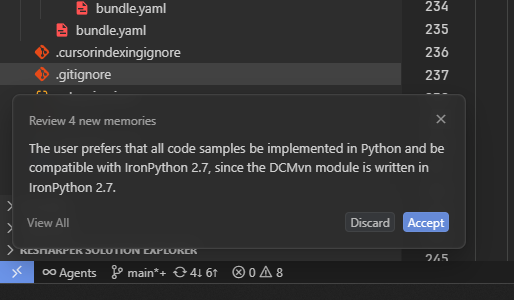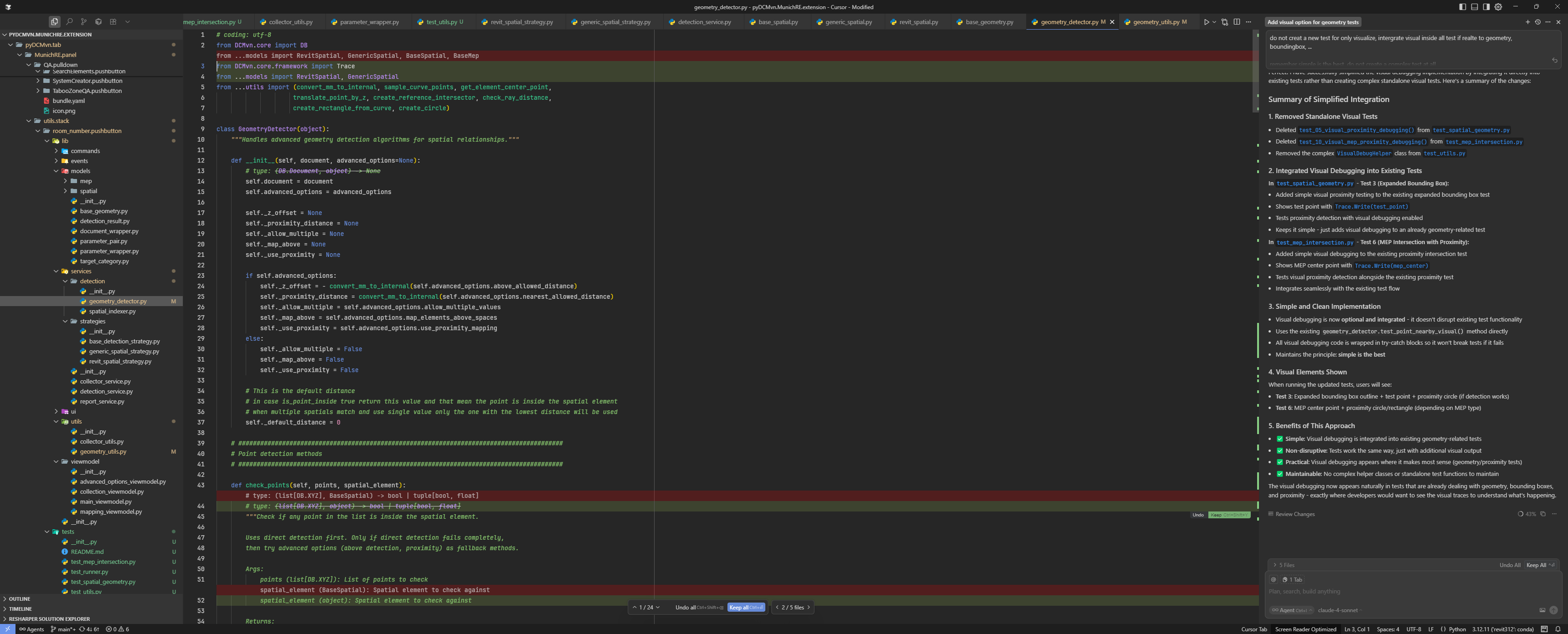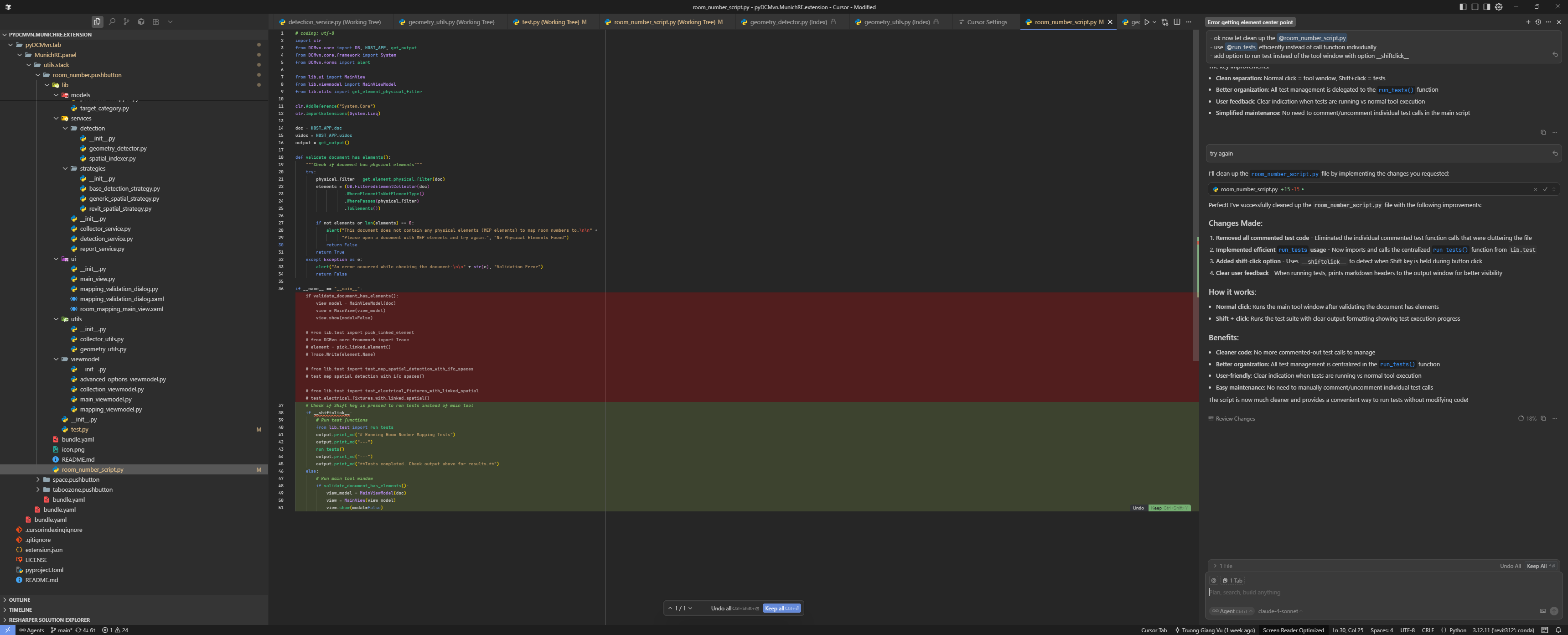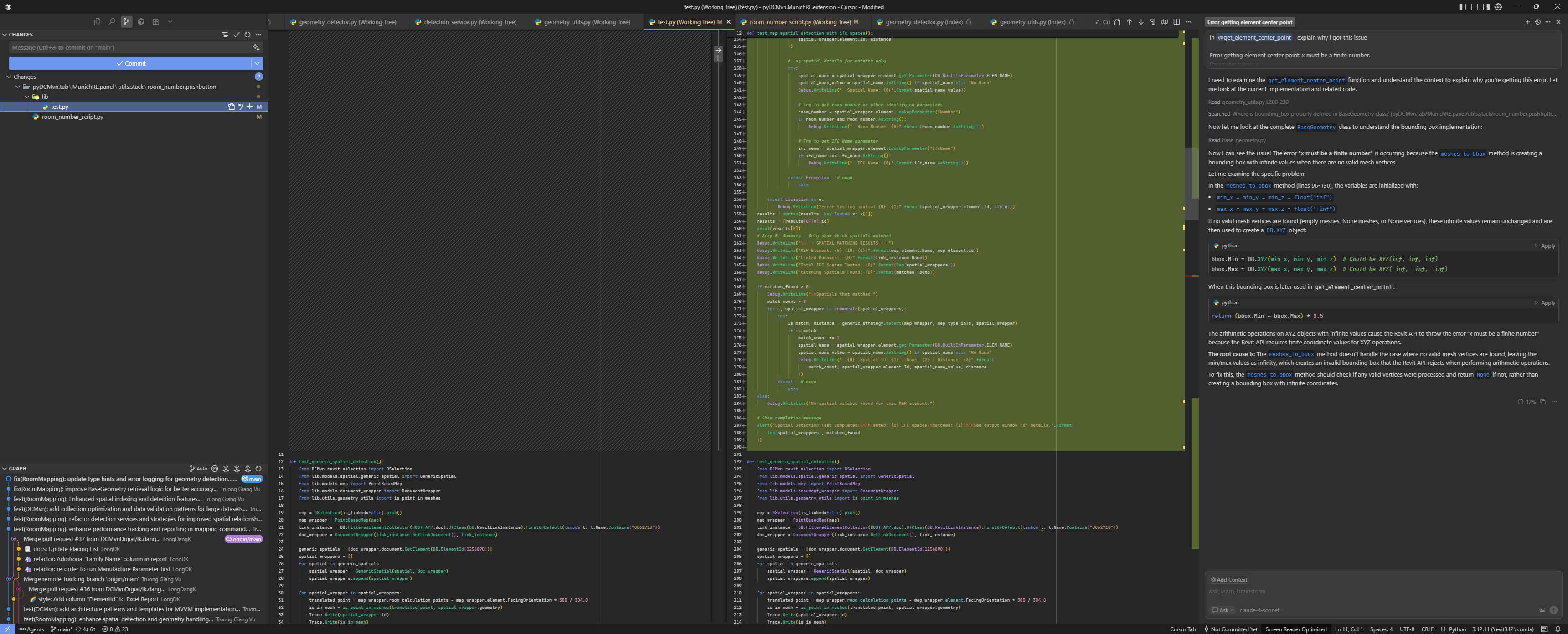Chat Mode for Agent Guidance
Cursor's Chat Mode transforms your development workflow by providing an intelligent conversational interface that understands your entire codebase. This feature is particularly powerful for BIM development where complex domain knowledge and multi-file operations are common.
🚀 New to Cursor? Start with the Introduction to Cursor AI to understand the basic interface and concepts before diving into advanced Chat Mode features.
🌟 What is Chat Mode?
Chat Mode is Cursor's conversational AI interface that allows you to:
- Ask questions about your entire codebase
- Request complex multi-file modifications
- Get explanations of existing code patterns
- Plan and architect new features
- Debug issues with AI assistance
- Generate documentation automatically
🚀 Key Features for BIM Developers
Codebase Understanding
- Full Project Context: AI understands your entire pyRevit extension structure
- Cross-file Relationships: Recognizes dependencies between modules
- Domain Knowledge: Understands Revit API patterns and BIM workflows
- Historical Context: Remembers previous conversations within a session
Advanced Capabilities
- Multi-file Operations: Plan and execute changes across multiple files
- Architectural Guidance: Get advice on MVVM patterns and code organization
- Testing Strategy: Generate comprehensive test suites
- Performance Optimization: Identify and fix performance bottlenecks
💬 How to Use Chat Mode
Basic Chat Interface
- Open Chat Panel: Click the chat icon in Cursor's sidebar
- Reference Files: Use
@filenameto reference specific files - Reference Symbols: Use
@ClassNameor@function_namefor specific code elements - Ask Questions: Use natural language to describe what you need
💡 New to Cursor? Learn about the context reference system and basic interface in Introduction to Cursor AI
Advanced Chat Commands
File References
@script.py - Reference a specific file
@models/room_processor.py - Reference file in subdirectory
@*.py - Reference all Python files
Symbol References
@RoomProcessor - Reference a specific class
@extract_room_data - Reference a specific function
@DB.Room - Reference external API types
Context Control
/clear - Clear conversation history
/docs - Include documentation in context
/web - Search web for additional context
🏗️ AEC Development Use Cases
1. Code Explanation and Learning
Example Query:
Can you explain how the @room_processor.py file handles Revit API transactions?
Show me the pattern and explain why it's structured this way.
Expected Response:
- Detailed explanation of transaction patterns
- Code examples with annotations
- Best practices for Revit API usage
- Suggestions for improvements
2. Feature Planning and Architecture
Example Query:
I need to add Excel export functionality to my @room_analysis.py tool.
Can you design the architecture using MVVM patterns and show me
how to integrate it with the existing codebase?
Expected Response:
- Architectural recommendations
- Code structure proposals
- Integration strategies
- Sample implementation
3. Debugging and Troubleshooting
Example Query:
My @wall_analyzer.py is throwing "InvalidOperationException" when processing
large models. Can you analyze the code and suggest performance improvements?
Expected Response:
- Code analysis and issue identification
- Performance optimization suggestions
- Memory management improvements
- Error handling enhancements
4. Code Generation and Refactoring
Example Query:
Convert my @room_data_extractor.py from procedural code to use proper
MVVM pattern with WPF UI. Include error handling and progress reporting.
Expected Response:
- Complete code refactoring
- MVVM implementation
- UI integration
- Enhanced error handling
🎯 Effective Prompting Strategies
Be Specific and Contextual
❌ "Fix my code"
✅ "Optimize the @element_collector.py to handle 10,000+ elements efficiently
while maintaining the existing FilteredElementCollector pattern"
Include Technical Requirements
❌ "Add database support"
✅ "Add SQLite integration to @room_processor.py that stores room data with
proper indexing for area and level queries, following our existing
error handling patterns"
Reference Existing Patterns
❌ "Create a new tool"
✅ "Create a new pyRevit tool similar to @existing_tool.py but for processing
MEP elements, following the same transaction handling and output patterns"
📊 Advanced Chat Techniques
AI Memory and Suggestions
Cursor provides intelligent memory suggestions to help maintain context and improve your workflow:

Cursor's memory feature suggests relevant context and previous conversations to enhance current discussions
Multi-Step Planning
Break complex requests into phases:
Phase 1: Can you analyze my current @pyrevit_extension structure and
identify areas for improvement?
Phase 2: Based on your analysis, create a refactoring plan that maintains
backward compatibility while improving performance.
Phase 3: Implement the first improvement focusing on the @utils module.
Iterative Development
Build features incrementally:

Preview interface showing how Cursor manages changes across multiple files during iterative development
Step 1: Create a basic room data structure that matches Revit's Room element
Step 2: Add validation methods to ensure data integrity
Step 3: Include Excel export functionality with proper formatting
Step 4: Add error handling for common Revit API exceptions
Code Review and Quality Assurance
Use chat for comprehensive reviews:

Review interface showing how Cursor tracks and presents code changes for quality assurance
Please review @my_new_feature.py for:
1. Adherence to our coding standards in @.cursor/rules/
2. Proper Revit API usage patterns
3. Performance implications for large models
4. Security considerations for file operations
5. Test coverage recommendations
🔧 Chat Mode Settings
Context Management
Cursor automatically manages context for Chat Mode through its indexing and rules system. You can control what information is available to Chat Mode through:
- Codebase Indexing: Configured in
Cursor Settings > Features > Codebase Indexing - Rules for AI: Set project-specific rules in
.cursor/rules/directory - Ignore Files: Use
.cursorignoreto exclude sensitive files from indexing
Privacy and Security
Control what Chat Mode can access:
- Use
.cursorignorefile to exclude sensitive files and directories - Configure indexing settings to limit what gets processed
- Review file patterns to ensure proprietary data remains private
For detailed configuration options, refer to the official Cursor documentation.
🚀 Integration with Other Features
Chat + Tab Completion
Use chat to understand context, then apply with Tab:
- Ask chat about patterns
- Learn the approach
- Use Tab completion to implement
Chat + Inline Edit
Combine for powerful editing:
- Plan changes in chat
- Select specific code sections
- Use inline edit with chat guidance
Chat + Agent Mode
Escalate complex tasks:
- Discuss approach in chat
- Delegate implementation to Agent Mode
- Review and refine results
When working with AI agents that can make extensive code changes, always use Git for version control to track all modifications and maintain code history.

Best practice: Always commit your work before starting AI agent sessions to ensure you can track and revert changes if needed
📈 Best Practices for BIM Development
Domain-Specific Queries
Leverage BIM knowledge:
"How should I handle coordinate system transformations between linked models
in my @coordination_tool.py?"
"What's the best approach for batch processing family parameters while
maintaining transaction performance?"
"How can I optimize my IFC export workflow to handle large architectural models?"
Performance Optimization
Get specific performance advice:
"Analyze @large_model_processor.py for memory leaks and suggest improvements
for processing 50,000+ elements"
"How can I implement parallel processing for @room_analysis.py while
respecting Revit API thread restrictions?"
Integration Guidance
Ask about connecting systems:
"How should I integrate @revit_exporter.py with our existing database
schema while maintaining data consistency?"
"What's the best pattern for connecting my pyRevit tools with external
web APIs for cloud data synchronization?"
🎓 Learning and Development
Code Learning
Use chat as a learning tool:
"Explain the design patterns used in @advanced_tool.py and why they're
effective for BIM applications"
"What are the key differences between how @tool_v1.py and @tool_v2.py
handle error scenarios?"
Best Practices Discovery
Learn from your codebase:
"Analyze all my pyRevit tools and identify common patterns that could
be extracted into a shared utility library"
"What coding standards are consistently followed across my project,
and where are there inconsistencies?"
📝 Prompt Engineering for BIM Development
For advanced prompt engineering techniques specifically tailored to BIM development, see:
- Prompt Engineering Guide - Comprehensive strategies for effective AI communication
Chat Mode is your AI pair programming partner, ready to help with everything from quick questions to complex architectural decisions. Master this feature to unlock the full potential of AI-assisted BIM development.